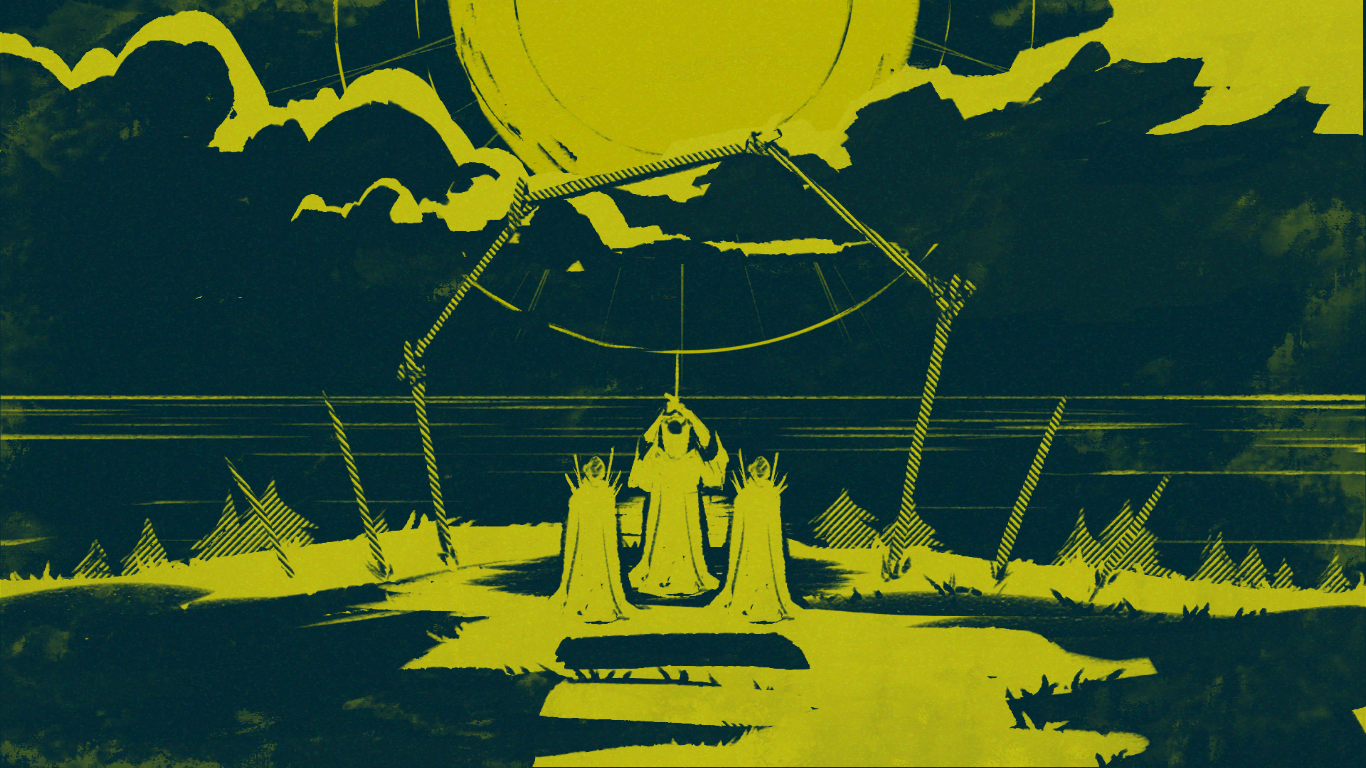As my fellow neighbor Zoya Efferson cracked a whip upon the back of those unfaithful to the black god Chernobog, I as a player had a slight moment of reflection and realization. It dawned on me that I had a smile on my face because of how well The Shrouded Isle realizes its demonic cult and allowing players to manage it.
The Shrouded Isle is a management simulator by developer Kitfox Games where you are bestowed the duty of preparing your isolated community for the awakening of the aforementioned dark and powerful deity Chernabog, who is prophesied to return in five years.
With a world drawn out by the talented Erica Lahie, The Shrouded Isle is immediately striking with it’s abstract, grim, two-tone pallete of sickly yellow and a faded blue. Each character in The Shrouded Isle is painted in that grim style, with their eyes always shrouded by a dark shadow. It’s unsettling and makes them feel as if they’re not people, making it easier to push them around.
![]()
This island you call home is ran by you and five families with a long lineage in the cult. With every season that passes by you get closer to Chernabog’s awakening. At the beginning of each season, you must select one member from each family to maintain the ignorance, fervor, discipline, penitence, and obedience in the community. The families must work together to maintain the societal controls necessary to keep the denizens of the island properly tame for the Dark Lord’s arrival.
Each family has a singular representative who has what is referred to in-game as a virtue (strength) and vice (weakness). In order to find out individual’s virtue and vice, you need to question them, and questioning is going to slowly lower your favor with that family that individual belongs to. So you could have a member that has a high ignorance but a low discipline and might not be the best person for the job, but the need to focus on a target attribute will force your to make imperfect choices. Each family has an assigned specialty and this individual is also representing their family. Whether or not you select them to do their assigned duty will have an effect on how that family feels about your management. This decision making process is at the heart of The Shrouded Isle.
As the leader, you watch them do their work. Book burnings, organized theft, and taking neighbors away to brutally interrogate them are all done in the name of this unseen otherworldly deity.
There are other key strategic elements to the game that give it a tension. One is that every house family has a percentage notating how satisfied or dissatisfied they are with you and their standing in the community. But questioning is not only necessary to discover who is best for the job, it’s also necessary for the final key element at the center of The Shrouded Isle and perhaps any great demonic cult in fiction, sacrifice.
At the end of every season, the community congregates at a cliffside in the island for that unholy ceremony that will lead to their desired salvation. The chosen sacrifice will come from one of your appointed leaders from each family. To choose the right person to sacrifice, you need to know who has the most severe vice or choose the person who Chernabog told you they want sacrificed through their vague description of them, such as “The Pervert” or “The Cowardly One.” Of course, you won’t know who that is if you don’t question the right people.
![]()
There are also random instances throughout playthroughs where an unexpected event occurs in your community. Perhaps an innovation in whip technology deserves your attention. How you handle these random events could change the standing of your attributes, reveal truths about individuals, and more. The version of the game that I played also included The Sunken Sins expansion which added more of these events as well as made some changes and additions to the vices in the game
Balancing all of these elements along with the game’s morbid and striking visuals is what makes The Shrouded Isle interesting and at times engrossing. The story and written dialogue is strong and evocative, but by the time I reached one of the game’s endings, the pacing and length of it left me frustrated and uninterested. Going through the game’s decision making cycles requires a lot of thought and attention, but after so many failures and having to see much of what you’ve already gone through, it becomes a bit exhausting.
Suddenly moments that hit hard before now feel mundane. The random events that are peppered throughout to change things up don’t really add that much to a change the pace, but they’re certainly welcomed. Once I finally reached an ending, it wasn’t the glorious return of a banished God that I was working towards, but instead ended with my character burning themselves alive as a sign of fervor and devotion. At that point, I felt like I saw enough.
Closing Comments:
Even though I finished my time with The Shrouded Isle on a low note, it doesn’t take away how tense and delightfully uneasy those first few hours with it were. Its art is distinct and I think it will stick with me for a good while. It’s writing brings out a sense of dread and horror, but also gives the goings-on weight. While its systems became too familiar after I spent a good amount of time with them, it doesn’t discount how effective they once were. Besides, I don’t get the feeling that The Shrouded Isle is attempting or expecting to be a game most players will spend dozens of hours with. It’s a strong piece of eldritch horror fiction.






